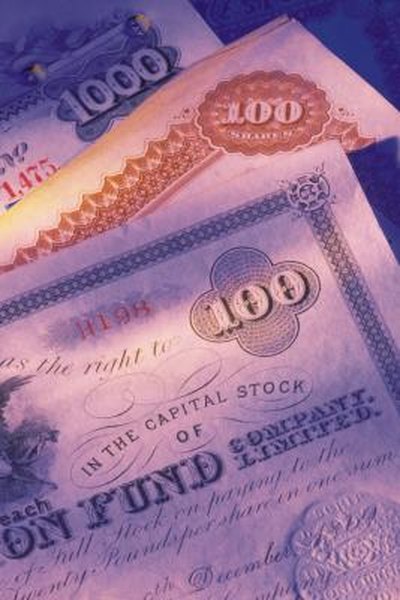Are Treasury Stocks the Same As Preferred Stocks?
Treasury stock consists of any common or preferred shares repurchased by the issuer.
Comstock/Comstock/Getty Images
Companies become public corporations by issuing common stock in an initial public offering. Corporations have only one kind of common stock, but they can issue multiple series of preferred stocks. Though both types of stock are classified as stockholder's equity, preferred and common stock are not the same. Treasury stock is common or preferred stock that has been repurchased by the issuing corporation and is no longer part of the outstanding shares that trade on stock markets.
Equity
Equity is the ownership interest in a corporation or property. Public corporations are owned by their shareholders. Assets, liabilities and earnings all belong to shareholders, who benefit from stock appreciation and dividends. Dividends are distributions of retained earnings, which are the accumulated profits of the corporation. The board of directors has the power to declare, change or suspend dividends. The board can issue new shares of common or preferred stock, but it also can establish programs to repurchase existing shares.
Preferred Stock
Corporations may choose to issue one or more series of preferred stock. This kind of stock pays a fixed, high dividend and has other special features. Preferred shareholders typically cannot vote on corporate matters. If a company is liquidated, the cash proceeds are first used to pay off creditors and then distributed to preferred shareholders. If any cash remains, it is allocated to holders of common stock. Common stock cannot pay dividends unless preferred dividends are fully paid first. Cumulative preferred shares require that all missed dividend payments be made before resuming common stock dividends.
Stock Issuance
Proceeds from the initial public offering of common stock are recorded in the shareholder equity accounts of the issuing corporation. Stock is issued with a nominal, or par, price per share. When the stock is issued, the corporation collects the proceeds, assigns the par value to an account called “paid-in capital” and places the rest of the proceeds into the “additional paid-in capital” account. For instance, suppose a corporation issues 10 million shares of a preferred stock, each share bearing a par value of $5. If the shares each fetch $25, the paid-in capital account is allocated $50 million and the remainder, $200 million, is recorded as additional paid-in capital.
Treasury Stock
A corporation can enter the secondary market and buy up its previously issued common shares at the current market price. The cash spent on these buybacks reduces the capital account balances. Repurchased, or ”treasury,” stock reduces the amount of common shares that participate in an earnings-per-share increase, which usually boosts common stock prices. Preferred stock can be repurchased at the market price or may have a “call” feature that allows the corporation to force shareholders to return the shares for a specified price. Corporations may convert outstanding preferred shares into treasury stock to cancel further dividend payments, thus conserving cash. Treasury stock is sometimes used to redeem employee stock options.
Resources
- Preferred Stock Investing; Doug K. Le Du
- Intermediate Accounting; Donald E. Kieso et al.
- Stock Investing for Dummies; Paul J. Mladjenovic
Writer Bio
Eric Bank is a senior business, finance and real estate writer, freelancing since 2002. He has written thousands of articles about business, finance, insurance, real estate, investing, annuities, taxes, credit repair, accounting and student loans. Eric writes articles, blogs and SEO-friendly website content for dozens of clients worldwide, including get.com, badcredit.org and valuepenguin.com. Eric holds two Master's Degrees -- in Business Administration and in Finance. His website is ericbank.com.

